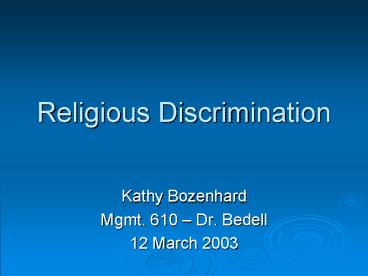Religious Discrimination - PowerPoint PPT Presentation
1 / 10
Title:
Religious Discrimination
Description:
Prohibits workplace discrimination (hiring, firing, promotion, benefits, ... Religious Discrimination increased by 21% between 2001 and 2002. Cases. EEOC vs. Brinks ... – PowerPoint PPT presentation
Number of Views:3253
Avg rating:3.0/5.0
Title: Religious Discrimination
1
Religious Discrimination
- Kathy Bozenhard
- Mgmt. 610 Dr. Bedell
- 12 March 2003
2
Outline of Presentation
- Overview
- Employer Requirements
- Implications
- Cases
- Pros/Cons
- Recommendations
3
Overview
- Civil Rights Act of 1964, Title VII
- Prohibits workplace discrimination (hiring,
firing, promotion, benefits, training, and job
duties) based on religion, ethnicity, country of
origin, race and color. - Employers must accommodate religious beliefs and
practices.
4
Overview
- Covered individuals include all religious parties
including atheists. Decision based on whether
the belief takes the place of religion in the
employees life. - Members of the KKK are not included.
- Law affects all employers that have 15 or more
employees. Most unions and employment agencies
are also covered.
5
What is a religious belief?
- A belief concerning certain religious practices
that is sincerely held by an individual. - Courts will typically not second guess an
individuals religious beliefs. It is not the
courts duty to determine what is a religious
belief, but instead determine whether the beliefs
are sincerely held by an individual.
6
Requirements
- Employers must provide a workplace that is free
of harassment based on religion. - Employers are liable for harassment by
supervisors, co-workers or non-employees under
their control. - Employers should reasonably accommodate the
religious practices of an individual, unless
doing so would create an undue hardship
7
Implications
- Compensatory and Punitive Damages
- Depends on the size of the company.
- 15-100 Employees 50,000
- 101-200 Employees 100,000
- 201-500 Employees 200,000
- 500 Employees 300,000
- Back pay, benefits and legal fees.
- Injunctive or declaratory relief.
- Religious Discrimination increased by 21 between
2001 and 2002.
8
Cases
- EEOC vs. Brinks
- Cloutier vs. Costco
- Sattar vs. Motorola, Inc.
9
Pros and Cons
- Pros
- Employers are not required to spend a lot of or
make changes that could pose a threat to the
business operations. - Cons
- Must be handled very carefully.
- Gray area in between two extremes.
10
Recommendations
- Communicate harassment policy.
- Have clear policies for addressing complaints.
- Train managers on proper and effective responses.
- Document everything
- Form for requesting accommodation.
- Written acknowledgement by employee of request
response. - Documentation on why request was not granted.































